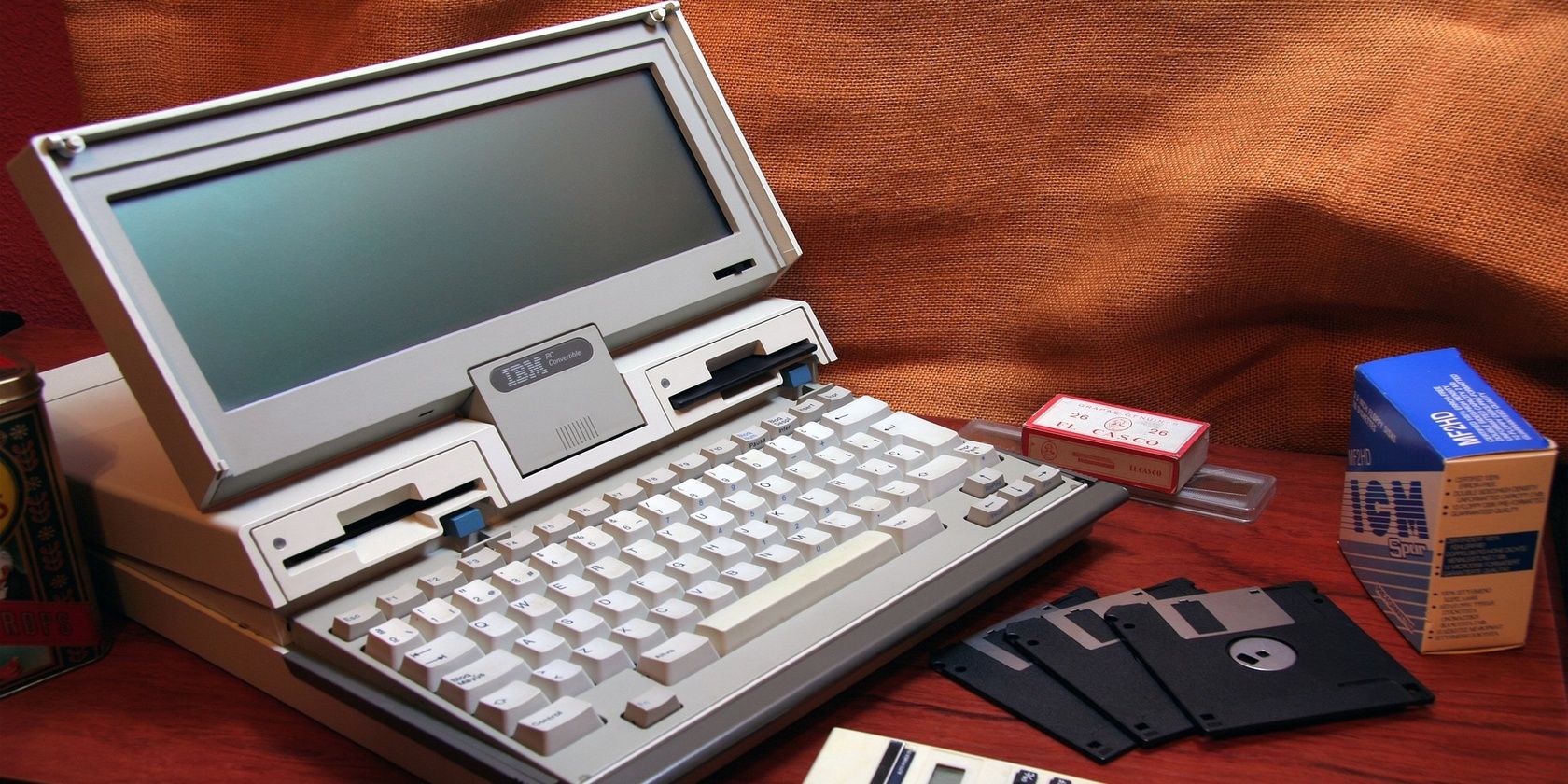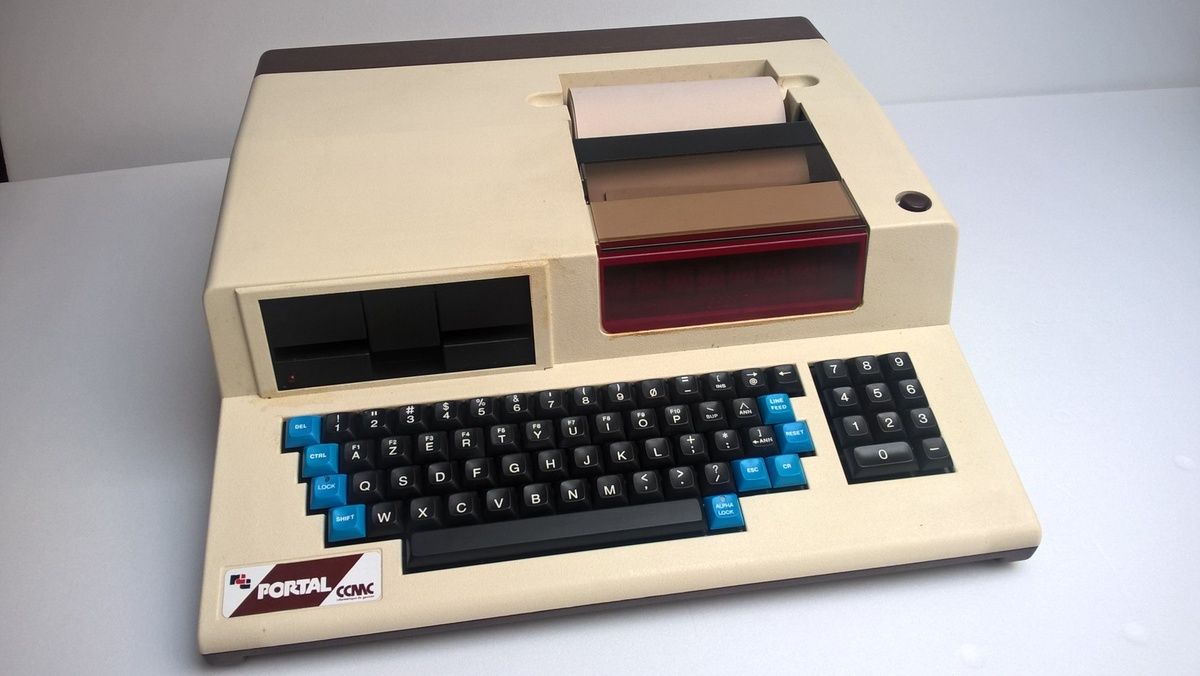Laptop computer accounted for 57% of PC sales in 2022. The handy clamshell design and lightweight hardware of notebook and ultrabook-style computers means that they can be taken and used almost anywhere.
Traditionally lower powered than their desktop counterparts, since around 2010 laptops have become the popular option for a new computer.
But who invented the first laptop computers?
The Creator of Portable Computers and Laptops
As you will soon see, early laptops and portable computers looked more like suitcases than books.
When was the first portable computer released, and who invented it?
The first obvious portable computer can be traced to the IBM 5100 (see below), created at the IBM Los Gatos Scientific Center by a team consisting of Dr. Paul Friedl and Bill Lowe. A few years later, Lowe would spearhead the creation of the first IBM PC.
These seven portable computers changed everything and heralded the laptop computing era.
1. IBM 5100
Widely regarded the first portable computer, the IBM 5100 was released in 1975. Back then, computers weighed the same as a small car, so this device was revolutionary.
Featuring an IBM PALM processor (1.9Mhz) and a maximum of 16Kb of RAM, the computer was certainly portable but weighed 25 kg (55lb). Furthermore, it had to be plugged in—there was no battery pack on this computer.
The IBM 5100 featured a 5-inch CRT monochrome display and an IBM DataCartridge tape drive. While the IBM 5100 wasn’t portable in the way we currently understand the term, it was an all-in-one unit that could be moved around and plugged in.
The entry level price of the IBM 5100 in 1975 was $8,975, around $25,000 today.
2. Epson HX-20
Considered by many to be the first actual portable computer or laptop, the Epson HX-20 was released in 1980. Sporting what is now known as a “cyberdeck” design, is featured dual Hitachi 6301 CPUs (614kHz), a maximum 32Kb RAM and up to 64kb ROM.
A compact four-line by 20 character (120×32 pixel) LCD was mounted alongside a dot-matrix printer and a microcassette drive, and the computer weighed just 1.6 kg (3.5lb).
Available with a transport case, the Epson HX-20 was powered by rechargeable nickel-cadmium batteries. Incredibly, these powered the computer for up to 50 hours!
New, the Epson HX-20 cost just $795 close to around $2160 in current terms.
3. R2E CCMC Portal
Also released in 1980, the R2E CCMC Portal was developed by French computer engineer François Gernelle and released by R2E Micral.
With a 2MHz Intel 8085 CPU and 64kb of RAM, the Portal featured a 32-character display, 5.25-inch floppy drive, and a thermal printer.
Like the IBM 5100, the Portal was not fully portable, but at 12 kg (26.5lb) was light enough to be resituated as needed.
Sold as a payroll and accounting tool, hundreds of machines were sold across France in the early 1980s. However, the Portal is incredibly rare, with only two known to be in existence.
No accurate pricing for the Portal is available.
4. Osborne 1
In 1981 a fully portable computer with a resemblance to the IBM 5100 was released. Weighing in at 11 kg (24.5lb) the Osborne 1 (or OCC-1) was developed by Adam Osborne at Osborne Computer Corporation.
Featuring a 4Mhz Zilog Z80 CPU (the same chip that would power many systems in the 8-bit era) and 64Kb of RAM, the Osborne 1 also had dual 5.25-inch floppy drives. When carried, the keyboard was clipped across the 5-inch monochrome CRT display and disk drives.
Various other computers used this type of design for early portable computers, including Commodore. The SX-64 is a rare portable version of rival 8-bit computer, the Commodore 64.
The Osborne 1’s launch price was $1795, which today would set you back around $5350.
5. GRiD Compass
Developed largely for NASA's nascent Space Shuttle program, work on the GRiD Compass began in 1979, and released in 1982. Designed by Bill Moggridge, the computer is regarded as the first “clamshell” laptop and featured an 8MHz Intel 8086 CPU, 34Kb of memory, a 320 × 240 display, and built-in modem.
Meanwhile, an IEEE-488 I/O bus enabled the connection of floppy and hard disk drives. As well as being used on Space Shuttle missions, the GRiD Compass was also used by US Special Forces.
Despite its form factor being hugely influential, the GRiD Compass was not equipped with a rechargeable battery. Instead, it required a standard 110/220V AC power supply.
Incredibly, this computer cost $8,150 in 1982 which would set you back $22,880 in today’s money.
6. Compaq Portable
In March 1983, this IBM-compatible portable PC was released. Behind the 9-inch green CRPT was an Intel 8088 CPU clocked at 4.77MHz and 128Kb of RAM. Storage was a choice of two 5.25-inch floppy drives or a single floppy plus 10MB hard disk drive.
Weighing 13 kg (28lb) the “closed” computer resembled a suitcase. Like the Osborne 1, the keyboard fastened to the base of the case, and required AC power—it had no battery.
The Compaq Portable cost $2,995, around $8,150 in current terms. As it was an IBM compatible, the Compaq Portable could run almost all first-generation PC software.
7. TRS-80 Model 100
While the portable computers above had a small impact, none of them made mobile working as easy as this did.
Released by Radio Shack and controlled by a 2.4MHz CPU, this 1983 portable computer featured up to 32Kb of RAM and an eight-line by 40 character (240 by 64 pixel) LCD. It also featured a 56-key QWERTY layout keyboard, a built-in modem, parallel printer port, and ran on four AA batteries. That would give you 20 hours of uptime and 30 days of memory storage.
What made the TRS-80 Model 100 particularly successful, however, was its early uptake by journalists. Their enthusiasm for the computer spread across (and beyond) the industry, eventually resulting in over 6 million sales for the computer.
While laptops had already begun to move away from the “cyberdeck” look of the TRS-80 Model 100, its impact on the perception of what we now consider “flexible working” is immeasurable.
The most basic version of the TRS-80 Model 100 laptop cost $1,099, around $3,000 today. It was so popular that various competitors created their own version of the TRS-80 Model 100.
Portability Enhances Productivity!
If you’ve ever used a laptop, then you will know that it changes the way you work. Documents can be written anywhere. Emails can be composed and sent from a train or plane. Reports can be checked and returned.
Mobile phones and tablets offer similar productivity boosts, but a laptop affords a full keyboard and display. It’s simply a different level of productivity, one that wouldn’t be possible with the pioneering portable computer engineering teams of IBM, Epson, Compaq, and the later success of the TRS-80 Model 100.


